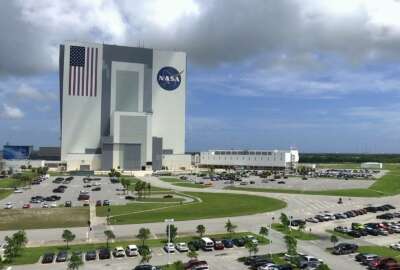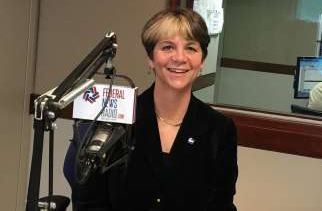
An update on the Hubble Telescope after three decades
This year, Hubble celebrated its 30th anniversary. To commemorate, NASA is releasing a collection of more than 50 newly processed images of the cosmos
Best listening experience is on Chrome, Firefox or Safari. Subscribe to Federal Drive’s daily audio interviews on Apple Podcasts or PodcastOne.
Asked to picture the universe, most people likely think of an image from NASA’s Hubble Telescope. This year, Hubble celebrated its 30th anniversary. To commemorate, NASA is releasing a collection of newly processed images of the cosmos. For an update on how the telescope’s future looks, Federal Drive with Tom Temin producer Eric White spoke with the Hubble program’s senior project scientist, Dr. Jennifer Wiseman.
Interview transcript:
Dr. Jennifer Wiseman: We are so happy to be commemorating the 30th anniversary of operations of the Hubble Space Telescope. And so we are releasing 30 new images from the Hubble Space Telescope. In fact, we’ve already posted them online at NASA.gov/hubble. These are images of everything from distant galaxies to nearby clusters of stars and beautiful nebulae. And they are all objects that are in a catalog of astronomical objects called the Caldwell catalog. It is a catalogue of bright objects that if you are an eager person with your own telescope, you can see some of these yourself. They’re bright objects. But Hubble’s images, of course, give us much greater detail as we look at these these beautiful phenomena in space because Hubble has that sharp vision, because it’s above the Earth’s atmosphere. So that’s how we’re celebrating and we hope that people listening will look up these images and enjoy them.
Eric White: And so what were some of your favorite parts of looking at these images? And really, I mean, throughout your, I’m sure you’ve see hundreds of thousands of these over your career. Are there any that stick out to you still?
Dr. Jennifer Wiseman: I think what really always strikes me when I see images like this from the Hubble Space Telescope is how active and how beautiful our universe is. I mean, it’s really telling that we do not live in a stagnant universe, we live in a universe where stars are still forming. Even in our own solar system, we see activity and changing weather patterns on other planets, we see surprising things such as lately the Hubble has been studying an asteroid and a comet that have originated from outside our solar system, and they’re just passing through. And these new images we’re releasing, I think seeing also the detail of other galaxies and seeing how they are active as well. To me is very awe inspiring. And the beauty as well that’s revealed by these images just makes me kind of take a breath and say, you know we live in a really amazing beautiful universe. And it’s it’s good to kind of look up on roof and reflect on that every once in a while.
Eric White: Hubble is among the most if not the most famous of the telescope programs within NASA. Why do you think that for some reason Hubble has resonated with folks for as long as it has?
Dr. Jennifer Wiseman: Well, I think there’s several reasons for that, and you ask a good question. One is that Hubble is truly a superb platform for observing the universe because it was put in orbit around the Earth to get it above the clouds above the Earth’s atmosphere. And that enables Hubble to get much sharper images of deep space, we don’t have to look through a turbulent atmosphere, our atmosphere even filters out some types of light that Hubble can see like ultraviolet light, which tells us even more about distant objects in space. So Hubble truly is a fabulous platform for astronomy, and, in fact, it’s taught us things that we never would have dreamed up before about the universe. So it’s a scientific powerhouse. It’s also, I think, a great accomplishment that the astronaut program has been integral to the success of Hubble. So it’s really been exciting and dramatic over the years to see Hubble’s first deployment by astronauts. And then when it was first launched, there was a problem with Hubble’s optics. And so the first return mission of astronauts in 1993 created this drama of a repair of something that might have been a disaster for astronomy and for NASA, but instead was turned into a wonderful triumph for this through that successful repair mission. And then we’ve had several astronaut missions over the years to keep Hubble improved with new cameras and instruments. So Hubble has been basically refreshed to be a new telescope time and time again by these astronaut missions. And I think that really is exciting for people to watch and take part in and see how the astronaut program and science investigation can go hand in hand. And then finally, I think NASA has just done a wonderful thing by deciding early on that the images from the Hubble Space Telescope would be made easily accessible to the public. And this was even way back before we had the internet so easily usable, but NASA was busy trying to make sure that Hubble images were made quickly available and understandable to people around the country and around the world. And we’re still doing that. Now the Internet has facilitated that so much more. But that has made people be able to enjoy and be educated and blessed by the images and discoveries of Hubble. And also, it’s made people feel like Hubble is kind of their own eye in the sky, a friend, if you will. And so all of those things, I think, make Hubble basically a household name. Of course, it’s named after astronomer Edwin Hubble, but we all think of Hubble as this marvelous eye in the sky, which it is, and we think it will continue to be for quite a few years to come.
Eric White: Yeah, I can remember those pre-internet days, I have many NASA calendar that all include Hubble images, and we asked to get pictures sent to our classrooms. They really were trying to say, hey look, there’s cool stuff happening up there. What is your role in the actual project itself and how did you come to that?
Dr. Jennifer Wiseman: Well, I am something called the senior project scientist, there are several of us who are scientists working within NASA at Goddard Space Flight Center just north of Washington, along with a lot of engineers who oversee the operations of the Hubble Space Telescope. We also work closely with an organization called the Space Telescope Science Institute in Baltimore that has hundreds of people monitoring and managing the daily science work of Hubble, taking in proposals from scientists around the world who want to use the telescope. Conducting selection processes by experts who choose the best proposals to actually be done with Hubble, it’s very competitive. And then making sure that the the telescope is pointed correctly. That’s what our engineers at Goddard Space Flight Center also worked very hard on to make sure that we’re maintaining as best we can from the ground the the best use of the science instruments and the things that we need to make Hubble be able to do at science, it’s gyroscopes, its batteries. I oversee these things from a scientist perspective to make sure that we’re making decisions on the way Hubble is, is used and the way that we choose how to allocate the time for it and so forth in a way that brings us the best science return possible. And my favorite part of the job is getting to kind of review and express to others the the great new scientific discoveries of Hubble. Even Hubble being 30 years into its operation, Hubble is providing us kinds of information that we never would have even imagined when Hubble was first designed, like studying the compositions of atmospheres of planets outside our solar system. Back when I was in graduate school, we didn’t even know that of any planets outside of our solar system, they were too hard to detect. But now our telescopes are better, telescopes other than Hubble are discovering lots of these exoplanets, and then Hubble will hone in and look at their atmospheres and see what they’re made of. We’re also using Hubble to refine our understanding of the expansion of the whole universe by looking at distant galaxies and gauging their distances and matching that to their apparent velocities as they’re being stretched apart from each other with the expansion of space. These kinds of things are going on with with greater and greater zeal with the Hubble Space Telescope. And we’re excited about that. We’re using Hubble also to do things we can’t do with other telescopes like look in ultraviolet light at many many stars. We have a special dedicated program now of looking at stars and ultraviolet light, which we cannot do from the ground. And making sure that we’re collecting all these types of observations in a great archive that we’ll be able to access for many years to come even after the Hubble mission ends.
Copyright © 2025 Federal News Network. All rights reserved. This website is not intended for users located within the European Economic Area.
Tom Temin is host of the Federal Drive and has been providing insight on federal technology and management issues for more than 30 years.
Follow @tteminWFED





